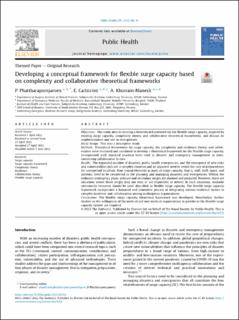| dc.identifier.citation | Phattharapornjaroen, P., Carlström, E. & Khorram-Manesh, A. (2022). Developing a conceptual framework for flexible surge capacity based on complexity and collaborative theoretical frameworks. Public Health, 208, 46-51. | en_US |
| dc.description.abstract | Objectives: This study aims to develop a theoretical framework for the flexible surge capacity, inspired by existing surge capacity, complexity theory, and collaborative theoretical frameworks, and discuss its implementation and use in emergencies.
Study design: This was a descriptive study.
Methods: Theoretical frameworks for surge capacity, the complexity and resilience theory, and collaboration were reviewed and combined to develop a theoretical framework for the flexible surge capacity, incorporated with standard practical tools used in disaster and emergency management as interconnecting collaborative factors.
Results: The expanded number of disasters, public health emergencies, and the emergence of new risks and vulnerabilities indicate a complex situation and an apparent need to revisit the core of preparedness for unexpected incidents. Four crucial elements as parts of surge capacity, that is, staff, stuff, space, and systems, need to be considered in the planning and managing disasters and emergencies. Within the ordinary contingency plans, primary and secondary surges are planned and prepared. However, there are situations where those surges may not exist or are impossible to deliver. In such situations, available community resources should be used, described as flexible surge capacity. The flexible surge capacity framework incorporates a balanced and innovative process of integrating various resilience factors in complex incidents and collaboration among multiagency organizations.
Conclusions: The flexible surge capacity theoretical framework was developed. Nonetheless, further studies on the willingness of the medical and non-medical organizations to partake in the flexible surge capacity system are required. | en_US |

